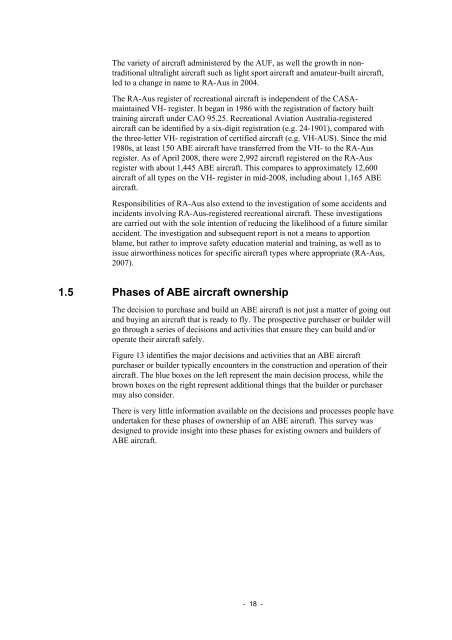Amateur-built and experimental aircraft - Australian Transport Safety ...
Amateur-built and experimental aircraft - Australian Transport Safety ...
Amateur-built and experimental aircraft - Australian Transport Safety ...
Create successful ePaper yourself
Turn your PDF publications into a flip-book with our unique Google optimized e-Paper software.
The variety of <strong>aircraft</strong> administered by the AUF, as well the growth in nontraditional<br />
ultralight <strong>aircraft</strong> such as light sport <strong>aircraft</strong> <strong>and</strong> amateur-<strong>built</strong> <strong>aircraft</strong>,<br />
led to a change in name to RA-Aus in 2004.<br />
The RA-Aus register of recreational <strong>aircraft</strong> is independent of the CASAmaintained<br />
VH- register. It began in 1986 with the registration of factory <strong>built</strong><br />
training <strong>aircraft</strong> under CAO 95.25. Recreational Aviation Australia-registered<br />
<strong>aircraft</strong> can be identified by a six-digit registration (e.g. 24-1901), compared with<br />
the three-letter VH- registration of certified <strong>aircraft</strong> (e.g. VH-AUS). Since the mid<br />
1980s, at least 150 ABE <strong>aircraft</strong> have transferred from the VH- to the RA-Aus<br />
register. As of April 2008, there were 2,992 <strong>aircraft</strong> registered on the RA-Aus<br />
register with about 1,445 ABE <strong>aircraft</strong>. This compares to approximately 12,600<br />
<strong>aircraft</strong> of all types on the VH- register in mid-2008, including about 1,165 ABE<br />
<strong>aircraft</strong>.<br />
Responsibilities of RA-Aus also extend to the investigation of some accidents <strong>and</strong><br />
incidents involving RA-Aus-registered recreational <strong>aircraft</strong>. These investigations<br />
are carried out with the sole intention of reducing the likelihood of a future similar<br />
accident. The investigation <strong>and</strong> subsequent report is not a means to apportion<br />
blame, but rather to improve safety education material <strong>and</strong> training, as well as to<br />
issue airworthiness notices for specific <strong>aircraft</strong> types where appropriate (RA-Aus,<br />
2007).<br />
1.5 Phases of ABE <strong>aircraft</strong> ownership<br />
The decision to purchase <strong>and</strong> build an ABE <strong>aircraft</strong> is not just a matter of going out<br />
<strong>and</strong> buying an <strong>aircraft</strong> that is ready to fly. The prospective purchaser or builder will<br />
go through a series of decisions <strong>and</strong> activities that ensure they can build <strong>and</strong>/or<br />
operate their <strong>aircraft</strong> safely.<br />
Figure 13 identifies the major decisions <strong>and</strong> activities that an ABE <strong>aircraft</strong><br />
purchaser or builder typically encounters in the construction <strong>and</strong> operation of their<br />
<strong>aircraft</strong>. The blue boxes on the left represent the main decision process, while the<br />
brown boxes on the right represent additional things that the builder or purchaser<br />
may also consider.<br />
There is very little information available on the decisions <strong>and</strong> processes people have<br />
undertaken for these phases of ownership of an ABE <strong>aircraft</strong>. This survey was<br />
designed to provide insight into these phases for existing owners <strong>and</strong> builders of<br />
ABE <strong>aircraft</strong>.<br />
- 18 -

















